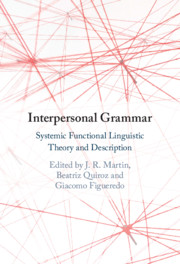Book contents
- Interpersonal Grammar
- Interpersonal Grammar
- Copyright page
- Contents
- Figures
- Tables
- Contributors
- 1 Introduction: Theory and Description in Interpersonal Grammar across Languages
- 2 Interpersonal Grammar in Spanish
- 3 Interpersonal Grammar in Khorchin Mongolian
- 4 Interpersonal Grammar in Mandarin
- 5 Interpersonal Grammar in Tagalog: Assessment Systems
- 6 Interpersonal Grammar of Pitjantjatjara
- 7 Interpersonal Grammar in Brazilian Portuguese
- 8 Interpersonal Grammar in British Sign Language
- 9 Interpersonal Grammar in Scottish Gaelic
- Index
- References
6 - Interpersonal Grammar of Pitjantjatjara
Published online by Cambridge University Press: 21 May 2021
- Interpersonal Grammar
- Interpersonal Grammar
- Copyright page
- Contents
- Figures
- Tables
- Contributors
- 1 Introduction: Theory and Description in Interpersonal Grammar across Languages
- 2 Interpersonal Grammar in Spanish
- 3 Interpersonal Grammar in Khorchin Mongolian
- 4 Interpersonal Grammar in Mandarin
- 5 Interpersonal Grammar in Tagalog: Assessment Systems
- 6 Interpersonal Grammar of Pitjantjatjara
- 7 Interpersonal Grammar in Brazilian Portuguese
- 8 Interpersonal Grammar in British Sign Language
- 9 Interpersonal Grammar in Scottish Gaelic
- Index
- References
Summary
This chapter focuses on the lexicogrammatical systems of IMPERATIVE MOOD and INDICATIVE MOOD in the Australian language, Pitjantjatjara, in relation to the discourse-semantic systems of NEGOTIATION, SPEECH FUNCTION, ENGAGEMENT and GRADUATION and the phonological system of TONE. It treats co-selections of features in MOOD and TONE as instantial couplings (Martin 2008) that realise variations in speech function. This discourse-semantic orientation departs from the treatment in Halliday (1967), Halliday & Greaves (2008) and Rose (2001, 2008) of tone/mood relations in terms of grammatical delicacy. Options in NEGOTIATION and SPEECH FUNCTION are illustrated with a series of exchanges that exemplify the coupling of MOOD and TONE selections. Imperative and indicative mood systems are then described in detail and exemplified with mood/tone couplings, including options for metaphors of mood. The chapter concludes by outlining grammatical and phonological realisations of ENGAGEMENT and GRADUATION, including the lexicogrammatical system of MODAL ASSESSMENT.
- Type
- Chapter
- Information
- Interpersonal GrammarSystemic Functional Linguistic Theory and Description, pp. 160 - 190Publisher: Cambridge University PressPrint publication year: 2021
References
- 2
- Cited by



